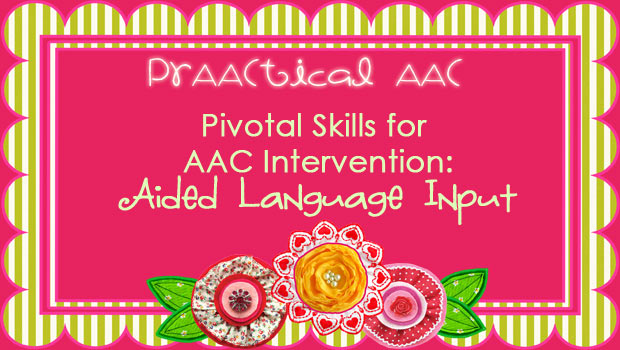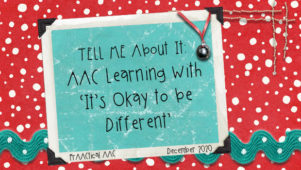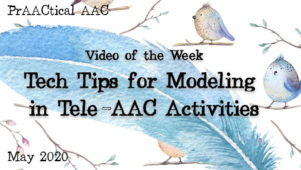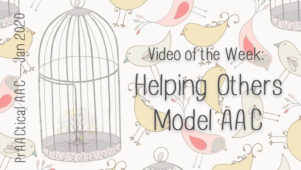Pivotal Skills for AAC Intervention: Aided Language Input

We can’t seem to stop talking about the power of aided language input. It’s one of those strategies that make our sessions more effective and make our clinicians more comfortable with the learner’s AAC system. And when other team members see us using it, they can’t help but pick up on the importance of aided modeling for people who are still learning to use their communication boards, books, SGDs, and mobile devices.
–
- Modeling, AAC Style (clinical rationale, research supports)
- AACtual Progress: Learning to use Aided Language Input (lessons learned)
- Strategy of the Month: Aided Language Input (screencast overview)
- Using the Device/App: Getting the Team on Board (implementation)
- Teachers in AACtion: Aided Language Input (video)
- Why We Love Aided Language Input (clinical rationale)
- Curated Resources for Aided Language Input (miscellaneous info, videos)
- Video of the Week: Aided Language Input Demo (video)
- 5 Tools to Make Aided Language Input Easier
–
Filed under: PrAACtical Thinking
Tagged With: aided language input, intervention
This post was written by Carole Zangari





5 Comments
Great to see you put modelling top of the list here! Apart from the direct teaching aspect, modelling also serves to validate the use of an AAC system (to the person learning)and in addition provides support people with direct insight into what it is like to be an AAC user.
Thanks for your comment, David. Yes, it is one of those strategies that, when used appropriately, is incredibly powerful. It takes awhile to get the hang of it, but it is worth the effort.
Researchers in Italy, in particular Antonella Costantino, a neuropsychiatrist specializing in AAC, Literacy for Significant Disabilities has a very interesting program. Dr. Costantino approaches communication AND aided language from the literacy perspective first. Parent TEAMS (and it must include at least 2 family members) are provided with training in reading and writing adapted books with each word augmented with visuals (text and icons). Families then make all kinds of books as well as augment trade books for their kids. After 6 months, AAC as communication is introduced. Dr Costantino finds that once parents have had lots of experience reading “symbolated” text to their children, the leap to augmenting communicative input is easy. While I completely understand the research on symbols interfering with print processing, this approach is fascinating and compelling. It brings several research questions to mind: Does augmenting text for our youngest readers and communicators increase shifting attention from text to reading partner? Or does it highjack interaction and experience sharing by creating hyper focus on symbols rather than the reading partner? Is there an age or developmental stage where anything that promotes attention shifting and interaction between reading partners is a benefit regardless of symbol use or not? In my experience with our youngest kids with ASD and their teachers and parents,augmenting text with symbols seems to promote a focus on the encapsulated symbol with text, while also promoting attention shifting. BUT, I have not compared this with a variety of other permutations, such as text only, symbols with boxes, symbols without boxes, etc. These are research questions that beg study.
Thnaks for your comment, Joanne. There are so many paths to getting kids the kind of AAC support they need. I think when we focus too much on the ‘best’ way it sometimes holds us back from doing anything at all. I love hearing about creative approaches to implementing AAC. Looking forward to hearing more about this as they move forward. 🙂
Are there new links to the above? I only found #8 to be working. Thank you!